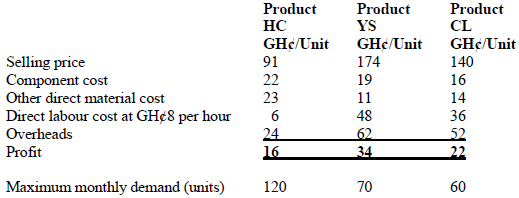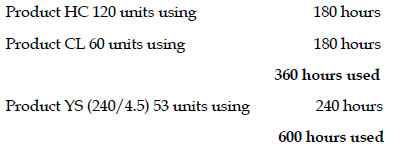KYC Ltd makes three products Hand Chew (HC), Yogurt Swallow (YS) and Canned Lick (CL). All three products are sold as a package and so are offered for sale each month in order to be able to provide a complete market service. The products are fragile and their quality deteriorates rapidly once they are manufactured. The products are produced on two types of machine and worked on by a single grade of direct labour. Five direct employees are paid GH¢8 per hour for a guaranteed minimum of 160 hours each per month. All of the products are first moulded on machine type 1 and then finished and sealed on machine type 2. The machine hour requirements for each of the products are as follows:

The capacity of the available machines type 1 and 2 are 600 hours and 500 hours per month respectively. Details of the selling prices, unit costs and monthly demand for the three products are as follows:

Although KYC Ltd uses marginal costing and contribution analysis as the basis for its decision making activities, profits are reported in the monthly management accounts using the absorption costing basis. Finished goods (inventories) are valued in the monthly management accounts at full absorption cost.
Required:
i) Calculate the machine utilisation rate per month for each machine and explain which of the machines is the bottleneck/limiting factor. (4 marks)
View Solution

Machine type 1 has the highest utilisation rate and the rate is above 100%. Therefore machine type 1 is the bottleneck/limiting factor.
ii) Using the current system of marginal costing and contribution analysis, calculate the profit maximising monthly output of the three products. (5 marks)
View Solution

Allocation of machine type 1 hours according to this ranking:

